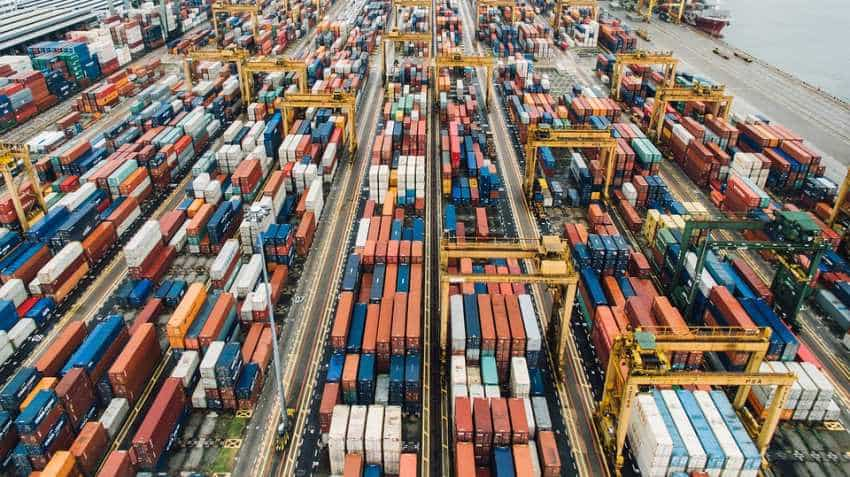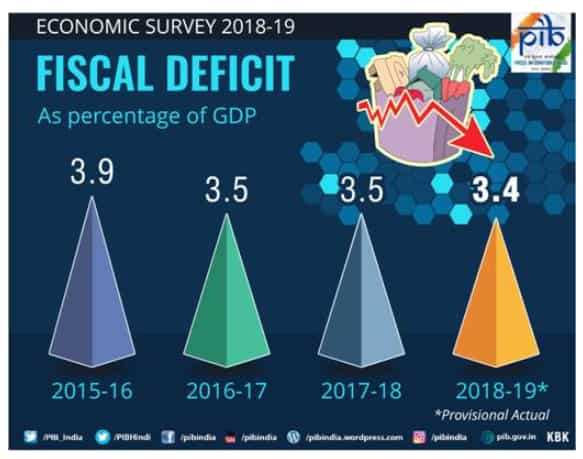Economic Survey: Coming year may pose challenges on fiscal front, but 3% deficit target achievable in FY21
Economic Survey: For FY19, the government had pegged fiscal deficit target of 3.4% of GDP.

Just a day before the final budget 2019 announcement, the Ministry of Finance released the Economic Survey for 2018-19, where it pointed out that several challenges face India's on the fiscal front. However, a ray of hope was also highlighted, as the government will be able to achieve its fiscal deficit target of 3% of GDP by FY20-21. Data released by controller general of accounts revealed that India's fiscal deficit came in at Rs 3.66 trillion already in the first two months of FY20, which has clocked 52% of full-year budget target. For FY19, the government had pegged fiscal deficit target of 3.4% of GDP.
According to the survey, the revised fiscal glide path envisages achieving fiscal deficit of 3 per cent of GDP by FY 2020-21 and Central Government debt to 40 per cent of GDP by 2024-25. The Survey notes the Medium Term Fiscal Policy Statement presented along with the Union Budget 2018-19 aimed to reach the fiscal deficit target of 3.3 per cent of GDP in 2018-19 BE.
The survey said, "The FY 2018-19 has ended with fiscal deficit at 3.4 per cent of GDP and debt to GDP ratio of 44.5 per cent (Provisional). As per cent of GDP, total Central Government expenditure fell by 0.3 percentage points in 2018-19 PA over 2017-18, with 0.4 percentage point’s reduction in revenue expenditure and 0.1 percentage point increase in capital expenditure. With respect to States finances, their own tax and non-tax revenue display robust growth in 2017-18 RE which is envisaged to be maintained in 2018-19 BE."

Cautioning, the economic survey says, " the coming year will pose several challenges on the fiscal front."
Firstly, there are apprehensions of slowing of growth, which will have implications for revenue collections. Secondly, the financial year 2018-19 has ended with shortfall in GST collections. Therefore, revenue buoyancy of GST will be key to improved resource position of both Central and State Governments.
Thirdly, resources for now expanded Pradhan Mantri Kisan Samman Nidhi (PM-KISAN) and Ayushmaan Bharat, as well as new initiatives of the new Government, will have to be found without compromising the fiscal deficit target as per the revised glide path.
Also, US sanctions on oil import from Iran is likely to have impact on oil prices and thereby on the petroleum subsidy, apart from implications for current account balances.
Finally, Fifteenth Finance Commission will submit its report for next five years beginning April 2020. Its recommendation especially on tax devolution will have implications for Central Government finances.
“Broadening and deepening the direct tax base and stabilization of Goods and Services Tax are the other priorities. Improving the quality of expenditure remains the key priority. Meeting allocational requirements without diversion from the newly revised fiscal glide path remains the foremost challenge. Despite several headwinds, Indian economy is expected to grow at 6.8 per cent (as per provisional estimates released by Central Statistics Office) in 2018-19 while maintaining macro-economic stability. The growth with macro-stability stems mainly from ongoing structural reform, fiscal discipline, efficient delivery of services and financial inclusion”, says the Survey.
03:00 PM IST






 Budget 2020: Follow Chinese model to create 4 crore jobs by 2025, says ES
Budget 2020: Follow Chinese model to create 4 crore jobs by 2025, says ES iPods and jobs: Economic Survey proposes 'Assemble in India'
iPods and jobs: Economic Survey proposes 'Assemble in India' Govt spending on social sector rose in five years: Economic Survey
Govt spending on social sector rose in five years: Economic Survey Budget 2020: GDP growth expected to strongly rebound to 6-6.5 pc in FY'21: Eco Survey
Budget 2020: GDP growth expected to strongly rebound to 6-6.5 pc in FY'21: Eco Survey Economic Survey 2020 urges public sector banks to improve governance, build trust
Economic Survey 2020 urges public sector banks to improve governance, build trust